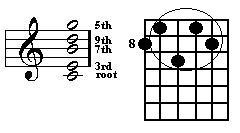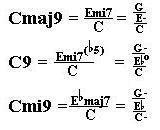
Adding a 9th to a Cmaj7 chord creates a Cmaj9. We now have 4 notes above the root, not 3. So we now have an upper extension 7th chord. Here's how it looks on the staff. Notice the upper 4 notes:
E - G - B - D. This spells an Emi7 chord. So we can now say that
Cmaj9 = Emi7/C.
On the guitar a close voicing like the above is impossible to finger so the voicing is opened up - the 5th is taken out of the middle and raised an octave. Even with the chord re-voiced the Emi7 is easy to see.

So now when soloing over a Cmaj9 chord we can use our Emi7 "stuff".
A Major 9 chord can be even further deconstructed. Remember from the previous page how a 7th Chord is a triad over a root that's not in the triad? The upper extension triad of an Emi7 chord is G major. So for a Cmaj9 chord we have a stack of 3 different triads:
C major, E minor, and G major.

The soloist can use any or all of these tonalities when soloing over Cmaj9. All this stuff can go the other way as well. The chord might be just a basic C major but by soloing in
G major, Emi or Emi7, Cmaj9 is implied by the soloist.



